Evaluation of the taxonomic composition of phytoplankton using microscopy and CHEMTAX in Todos Santos Bay (Baja California, México) during 2017-2018
IF 0.8
4区 农林科学
Q3 FISHERIES
Latin American Journal of Aquatic Research
Pub Date : 2023-04-30
DOI:10.3856/vol51-issue2-fulltext-2988
引用次数: 0
Abstract
This study analyzes the spatial and temporal variability of phytoplankton biomass and taxonomic composition in the surface waters of Todos Santos Bay, a semi-enclosed bay within the upwelling zone of the Baja California peninsula (México). Two methodological approaches (microscopy and chemotaxonomy [CHEMTAX]) were used to describe the variability of some genera and species (observed under the microscope) and the importance of those groups that cannot be observed microscopically. Phytoplankton biomarker pigments were measured with high-resolution liquid chromatography and used as input to run the CHEMTAX software to determine the contribution of the main phytoplankton groups to chlorophyll-a (Chl-a). The microscopic analyses showed that diatoms and dinoflagellates comprised 65 and 33% of the total cells, respectively. Dinoflagellates were most abundant in the inner bay and during cold months; the most frequent and abundant genera were Tripos, Protoperidinium, and Prorocentrum. Among diatoms, the most frequent genera were Cylindrotheca, Guinardia, Navicula, Pseudo-nitzschia, and Chaetoceros. CHEMTAX indicated that, together with diatoms, the flagellates prymnesiophytes and chlorophytes contributed a median of 80% to Chl-a, with chlorophytes as the most important group (29.9%). The high contribution of these flagellates suggests that they are represented by small-sized cells not visible by the light microscopy used. However, CHEMTAX largely underestimated the contribution of dinoflagellates (due to the presence of many mixotrophic species). Hence, our results emphasize the importance of using both techniques for a more detailed evaluation of the taxonomic composition of phytoplankton in this and other coastal regions.2017-2018年Todos Santos湾(Baja California, m xico)浮游植物分类组成的显微镜和CHEMTAX评价
本研究分析了托多斯桑托斯湾表层水中浮游植物生物量和分类组成的空间和时间变化,托多斯Santos湾是下加利福尼亚半岛(墨西哥)上升流带内的一个半封闭海湾。使用两种方法学方法(显微镜和化学分类学[CHEMTAX])来描述一些属和种的变异性(在显微镜下观察到)以及那些无法在显微镜下观测到的组的重要性。用高分辨率液相色谱法测量浮游植物生物标志物色素,并将其用作运行CHEMTAX软件的输入,以确定主要浮游植物类群对叶绿素a(Chl-a)的贡献。显微镜分析表明,硅藻和甲藻分别占总细胞的65%和33%。甲藻在内湾和寒冷月份最为丰富;最常见和最丰富的属是Tripos属、Protoparidinium属和Prorocentrum属。在硅藻中,最常见的属是Cylindrotheca、Guinardia、Navicula、Pseudo-nitzschia和Chaetoceros。CHEMTAX指出,与硅藻一起,鞭毛虫、prymnesiophytes和叶绿素对Chl-a的贡献中值为80%,其中叶绿素是最重要的一组(29.9%)。这些鞭毛虫的高贡献表明,它们是由所用光学显微镜看不到的小细胞代表的。然而,CHEMTAX在很大程度上低估了甲藻的贡献(由于存在许多混合营养物种)。因此,我们的研究结果强调了使用这两种技术对该地区和其他沿海地区浮游植物分类组成进行更详细评估的重要性。
本文章由计算机程序翻译,如有差异,请以英文原文为准。
求助全文
约1分钟内获得全文
求助全文
来源期刊

Latin American Journal of Aquatic Research
FISHERIES-MARINE & FRESHWATER BIOLOGY
CiteScore
1.70
自引率
10.00%
发文量
44
审稿时长
4-8 weeks
期刊介绍:
Latin American Journal of Aquatic Research- LAJAR is the continuation of the journal Investigaciones Marinas (1970-2007) and is published since 2008 by the Escuela de Ciencias del Mar, Facultad de Ciencias del Mar y Geografía of the Pontificia Universidad Católica de Valparaíso. LAJAR is an “Open Access” journal that publishes in English language, original research articles, reviews and short communications on aquatic science, which contain the results of research conducted in aquaculture or in oceanic and coastal marine waters of Latin America.
The following topics are considered: Physical Oceanography, Chemical Oceanography, Marine Biogeochemistry, Marine Pollution and Toxicology, Marine Geology and Geophysics, Biological Oceanography, Fisheries and Aquaculture.
 求助内容:
求助内容: 应助结果提醒方式:
应助结果提醒方式:


